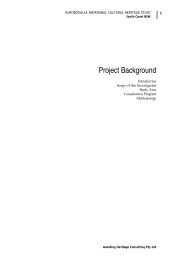Eurobodalla Integrated Water Cycle Management Strategy
Eurobodalla Integrated Water Cycle Management Strategy
Eurobodalla Integrated Water Cycle Management Strategy
Create successful ePaper yourself
Turn your PDF publications into a flip-book with our unique Google optimized e-Paper software.
132<br />
Stormwater<br />
<strong>Eurobodalla</strong> <strong>Integrated</strong> <strong>Water</strong> <strong>Cycle</strong> <strong>Management</strong> <strong>Strategy</strong><br />
In the absence of stormwater quantity and quality monitoring, preliminary estimates suggest<br />
that the annual stormwater volume discharge from the urban area is 16 000 kL, with<br />
nitrogen and phosphorus loads of 15 200 kg and 2 000 kg respectively.<br />
A detailed analysis of each sub-catchment is contained in appendix W. Issues relating to<br />
stormwater management and the infrastructure used for its management have been<br />
identified, as follows:<br />
Whilst most of the stormwater pipes have been recorded into the GIS, critical<br />
information such as pipe size, age, slope, etc. is missing.<br />
The GIS and the corresponding database does not include information on water<br />
quality control measures that have been installed.<br />
There is a general lack of urban stormwater quantity and quality information.<br />
There is no formal approach to stormwater management that will result in better<br />
management and efficient use of this resource.<br />
Short Beach Creek sub-catchment floods during local rainfall events and requires<br />
larger drainage pipes and/or source control measures, or greater maintenance to<br />
reduce blockages.<br />
There are no treatment measures in place to capture/remove hydrocarbon<br />
pollutants from heavy traffic areas.<br />
Soil erosion is evident at some discharge points.<br />
Of all the sub-catchments in Batemans Bay, Short Beach, Surf Beach, Denhams<br />
Beach, Joes Creek and Wimbie Creek sub-catchments have been identified as<br />
requiring priority stormwater quantity and quality management measures.<br />
Except for the regular removal of garbage from the public bins, there is no active<br />
litter and sediment removal/collection program. There is however a gross pollutant<br />
trap in the Batemans Bay Industrial Estate which discharges into Mcleods Creek<br />
(SEPP 14).<br />
9.4.3 How Do We Fix These Issues?<br />
Overview<br />
The landscape of the Batemans Bay area could be managed sustainably through the<br />
implementation of appropriate planning controls. The issues of future development and acid<br />
sulfate soil runoff could be managed by amending the local environmental and development<br />
control plans.<br />
There are a number of opportunities available to manage the water cycle of the Batemans<br />
Bay area. The traditional approach to water management is to separate water, wastewater<br />
and stormwater and treat each in isolation. In this strategy, all available opportunities have<br />
been identified and coarse screened (see appendix C). The coarse screening process<br />
recognises that there are immediate and short term measures, and medium to long term<br />
water cycle management opportunities. The immediate and short term measures need to<br />
be implemented as a matter of priority to achieve legislative compliance and best practice<br />
standards. The shortlisted medium to long term water cycle management opportunities<br />
would, in the long run, deliver water cycle sustainability, public health protection and<br />
improved service standards.

















